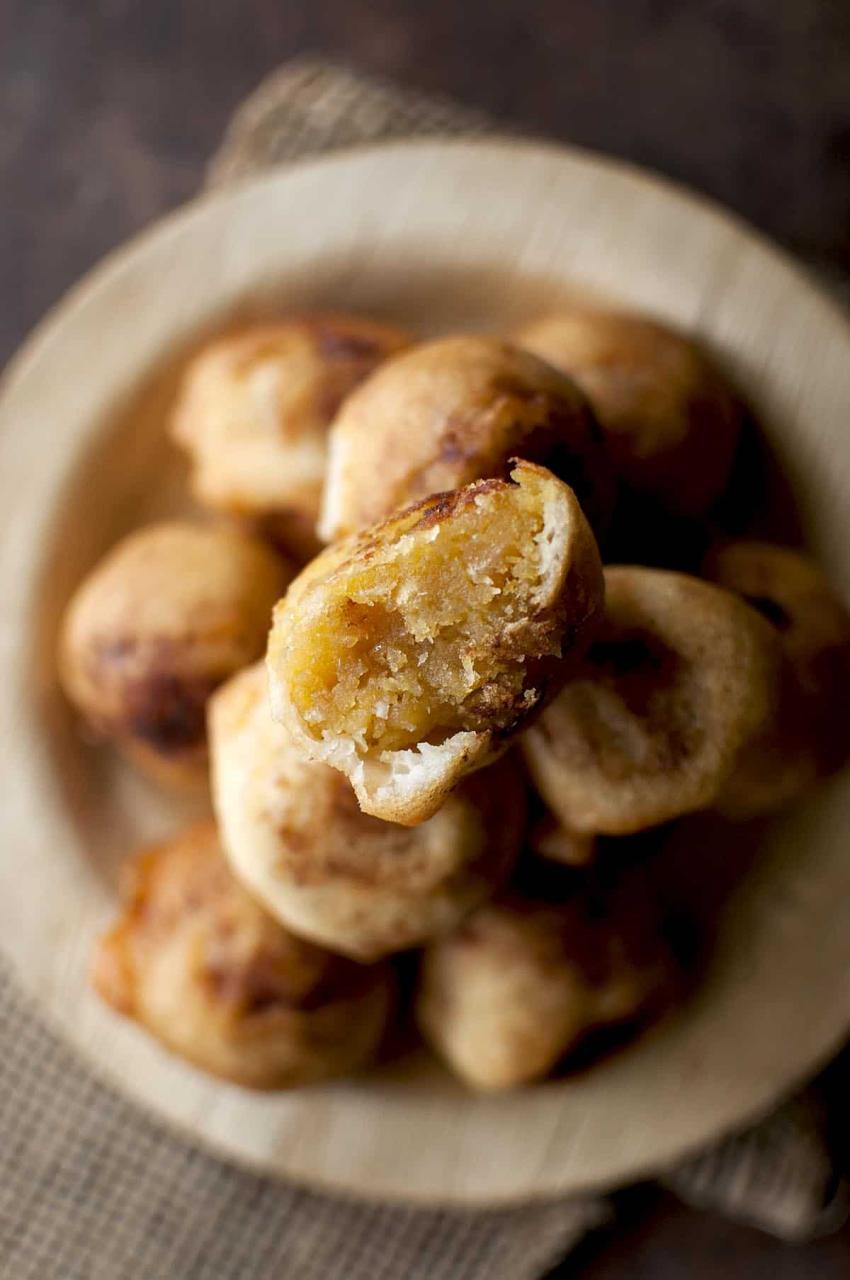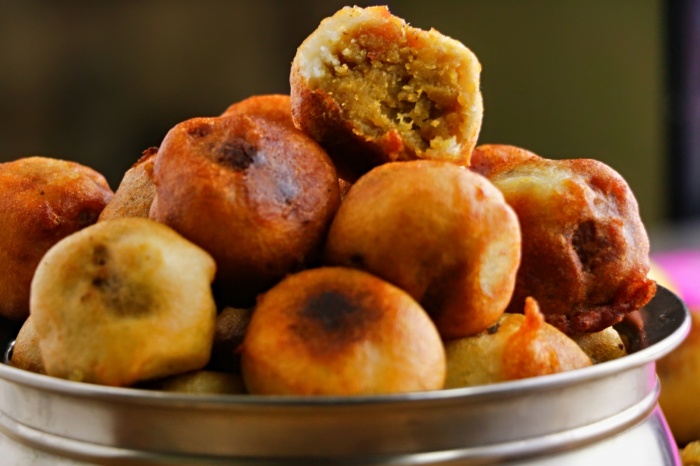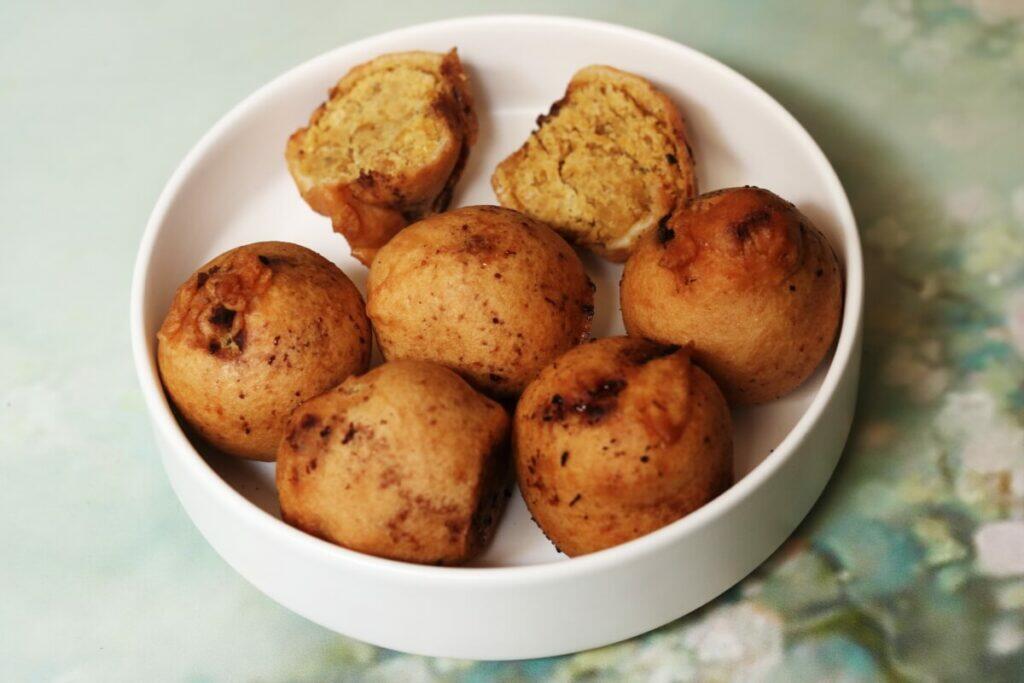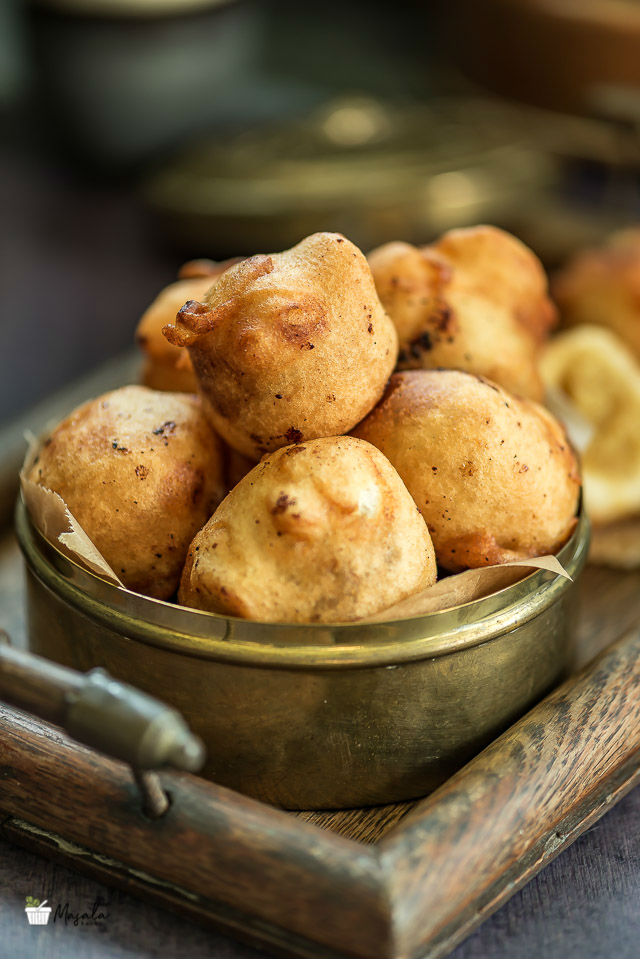Poornam Boorelu, also widely recognized in various parts of South India as Poornalu, is a traditional sweet that holds a special place in the culinary landscape of Andhra Pradesh. Celebrated particularly during festivals like Ugadi, Sankranti, and Deepavali, as well as during important religious ceremonies, this dessert captures the essence of festive joy and communal gatherings.
The dish consists of delicately crafted round dumplings made from rice flour and urad dal batter that encapsulates a delicious core of sweet filling. The filling, known as “Poornam,” is typically made from a mixture of chana dal or toor dal, blended with jaggery or sugar, and flavored with cardamom. This harmonious blend of sweetness wrapped in a light and soft outer shell, when deep-fried to golden perfection, offers a contrast of textures that is soul-satisfying.
Poornam Boorelu is not merely a treat to the palate but also an expression of traditional Andhra culinary artistry. Making these sweets requires skill and patience, especially to achieve the perfect balance between the crispy exterior and the meltingly soft, sweet interior. It’s a culinary practice that showcases the intricacy of Indian sweets, where texture and flavor play pivotal roles.
Poornam Boorelu Recipe


Poornam Boorelu
Equipment
- 1 medium bowl
- 1 medium skillet
Ingredients
FOR THE BATTER
- 1 cup sona masoori rice rinsed with cool water, drained
- 1/2 cup husked whole black lentils rinsed with cool water, drained
- 1/2 to 1 cup water
- 1/2 teaspoon salt
FOR THE STUFFING
- 6 teaspoons ghee plus more for serving
- 1/2 cup Bengal gram rinsed and drained
- 11/2 cups water
- 1 cup powdered jaggery
- 1/2 teaspoon ground cardamom
- 1/2 cup shredded fresh coconut or frozen, thawed to room temperature
- 1 cup vegetable or corn oil
Instructions
TO MAKE THE BATTER
- In a medium bowl, combine the rice, black lentils, and enough cold water to cover by 2 to 3 inches. Let soak at room temperature for 2 hours. Drain.
- In a blender, combine the drained rice and black lentils and 1⁄2 cup of water. Process until a smooth, thick batter forms. If it is too thick, add more water to get the right consistency—thick, smooth, and pourable, like idli batter. Add the salt and pulse to combine. Set aside.
TO MAKE THE STUFFING
- In a medium skillet over medium heat, melt 1 teaspoon of ghee.
- Add the Bengal gram and roast for about 3 minutes until it turns light brown. Remove from the heat and let cool.
- In an electric pressure cooker, such as the Instant Pot®, or stovetop pressure cooker or pressure pan, combine the cooled Bengal gram and water.
- For an electric pressure cooker, lock the lid into place and make sure the valve is in the Sealed position. Select Pressure Cook or Manual and set the time to 8 minutes on High Pressure. Let the pressure release naturally. For a stovetop pressure cooker, place it over medium heat and place the lid on. Ensure the sealing ring is on and place the weight on. Pressure cook until the cooker “whistles” 2 times. Let the pressure release naturally.
- Carefully unlock and remove the lid and drain the Bengal gram. Let cool.
- In a blender, combine the Bengal gram, jaggery, cardamom, and coconut. Process until a smooth paste forms. Set aside.
- Wipe out the skillet and return it to medium heat. Add 5 teaspoons of ghee to melt.
- Add the ground Bengal gram paste and cook for about 5 minutes until all the moisture is absorbed. Turn off the heat. When cool enough to handle, but still warm, form the mixture into 16 small lime-size stuffing balls.
- Line a plate with paper towel and set aside.
- In a large skillet over medium heat, heat the vegetable oil to between 350°F and 375°F. Test to see if the oil is hot enough by dropping 1 teaspoon of batter into the hot oil. If it sizzles and floats, without sinking, the oil is ready for frying.
- Working in batches of about four at a time, dip the stuffing balls into the batter, making sure they are well covered.
- Carefully drop the battered balls into the hot oil. Fry for 1 minute. Using a slotted spoon, slowly and carefully flip the fritters. Cook for 1 minute more, or until the bubbling sound stops. Use the spoon to transfer the fritters to the paper towel– lined plate to drain. Dip another batch of stuffing balls into the batter and continue frying. Serve with a dollop of ghee.
Notes
Cooking Tips about Poornam Boorelu

- Perfecting the Batter Consistency: The outer shell of Poornam Boorelu is made from rice flour and urad dal batter. Achieving the right consistency for the batter is crucial; it should be thick enough to coat the filling evenly but not too thick that it becomes heavy or doughy after frying. Aim for a silky smooth batter that falls off a spoon in a steady stream.
- Preparing the Filling (Poornam): For the filling, ideally use chana dal or toor dal mixed with jaggery. Cook the dal until it is just done – soft but not mushy. Overcooking the dal can make the filling pasty. After mixing the cooked dal with jaggery, the mixture should be dry enough to form into balls without sticking to your hands. This ensures the Boorelu hold their shape while frying.
- Flavoring the Filling: Enhancing the sweetness of the filling with cardamom powder adds an authentic flavor to Poornam Boorelu. You can also include a pinch of nutmeg or coconut pieces for added texture and taste.
- Balancing the Size: Ensuring the filling and batter are in proportion is key to perfect Poornam Boorelu. Too much filling can cause the Boorelu to burst open while frying, and too much batter may result in a cakey texture. A good balance is a small ball of filling (about the size of a marble) dipped in enough batter to create a thin coating all around.
- Deep Frying Technique: Heat the oil on medium flame to ensure even cooking. The oil should be hot enough so that when a drop of batter is added, it rises to the top immediately but doesn’t brown too quickly. Fry the Boorelu until they are golden brown, turning them occasionally for an even cook. Avoid overcrowding the pan, as this can lower the temperature of the oil and result in greasy Boorelu.
- Draining the Oil: Once fried, transfer the Boorelu onto a kitchen towel or paper towels to soak up any excess oil. This step ensures they don’t become soggy.
- Serving and Storage:Poornam Boorelu can be served warm or at room temperature. They are usually enjoyed as is, offering a burst of sweetness with each bite. If you need to store them, keep in an airtight container at room temperature for a day or refrigerate for extended freshness.
Serving suggestions about Poornam Boorelu

- Temperature Preference: Serve Poornam Boorelu either warm or at room temperature to bring out the flavors of the filling and maintain the texture of the batter coating. Serving them warm is particularly comforting during cooler weather or rainy days.
- Garnishing for Extra Flavor: While Poornam Boorelu are delicious on their own, you can garnish them with a sprinkle of powdered sugar or a drizzle of honey for added sweetness. A dusting of cardamom powder can also elevate the aromatic profile of the dish.
- Accompanying Beverages: Pair Poornam Boorelu with a cup of hot Indian tea, such as chai, or a light coffee. The robust flavors of the beverage complement the sweetness of the Boorelu, making for a balanced taste experience. For those preferring non-caffeinated options, a spiced buttermilk or a refreshing saffron-infused milk can be a delightful accompaniment.
- Presentation Matters: Present Poornam Boorelu on a platter garnished with edible flowers or leaves like mint, for an appealing aesthetic that enhances the overall dining pleasure. Traditional Indian serving dishes can also add to the authenticity of the meal.
- Festive Serving Suggestions: During festivals and special occasions, Poornam Boorelu can be served as part of a larger spread of sweets and savories. Arrange them alongside other festive treats to allow guests to enjoy a variety of flavors.
- Dessert Platter: Create a mixed dessert platter featuring Poornam Boorelu along with other traditional sweets like ladoos and jalebis. This allows for a delightful sampling of various textures and flavors, catering to different taste preferences.
Top 5 FAQs about Poornam Boorelu

- What is Poornam Boorelu? Poornam Boorelu is a classic sweet treat from Andhra Pradesh, popularly enjoyed during significant festivals like Ugadi, Sankranti, and Deepavali. It consists of round dumplings made from rice flour and urad dal batter, with a sweet filling made primarily of chana dal or toor dal and jaggery, flavored with cardamom.
- How does the texture of Poornam Boorelu contribute to its taste? The unique appeal of Poornam Boorelu lies in the harmonious contrast between its textures; the outer shell is light and crispy due to deep frying, while the inner filling is soft, moist, and sweet, providing a satisfying and soulful eating experience.
- Can Poornam Boorelu be made ahead of time, and how can they be stored? Yes, Poornam Boorelu can be made ahead of time. They should be stored in an airtight container at room temperature if intended to be consumed within a day, or refrigerated to extend their freshness. Before serving, they might be gently warmed up to enhance their flavour and texture.
- Are there any specific tips for ensuring the perfect preparation of Poornam Boorelu? Achieving the perfect Poornam Boorelu involves several key steps: ensuring the batter has the right consistency, preparing and flavoring the filling correctly, maintaining the balance between the size of the filling and the coating, mastering the deep-frying technique, and properly draining the oil post-frying to avoid greasiness.
- Can variations be introduced in the traditional recipe of Poornam Boorelu? While the traditional recipe holds a special place, variations can be explored mainly in the filling — such as incorporating coconut or nutmeg for different textures and flavors, or adjusting the type and amount of sweetener. However, any modifications should respect the balance and essence of the original flavors and textures typical of Poornam Boorelu.
Poornam Boorelu not only encapsulates the rich flavors and textures of Andhra Pradesh’s culinary tradition but also embodies the spirit of celebration, community, and tradition. These delightful sweet treats, with their crispy exterior and soft, flavorful filling, carry within them the essence of festive joy and communal gatherings that are central to Andhra society. The meticulous preparation process, from achieving the perfect batter consistency to mastering the filling and frying techniques, speaks volumes of the culinary expertise and patience woven into the fabric of regional Indian cooking practices.

Leave a Reply